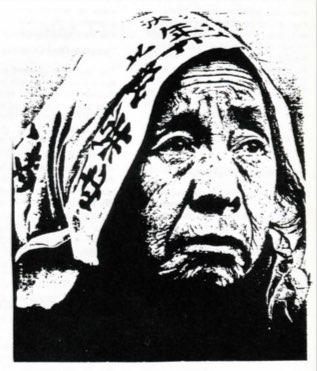JAPANESE COSMETICS INVADE ASIA
In the last received issue of the Asian Women's Liberation n. 5-82 (Shibuya Coop Rm 211/14-10 Sakuragaoka/Shibuya- ku, Tokyo 150, Japan), Japanese feminists denounce the "Cosmetics Drive into Asia". A big Japanese company, Shiseido, is accused of invading the Southeast Asia cosmetic market, selling "white beauty" to Asian women.
This is not only a consumers issue, but a feminist one as well. The manipulation is triple: economically, a market is created by creating a need. Secondly, women are exploited through the usual objectification of their bodies. And finally, third world women are sold a western model image, being led to believe that to be attractive they need to look western.
In the meantime, in our "industrialized" world, other big manipulators have been selling us the "exotic look", the "far islands' tan", the mascara which will lend to our eyes the "mysterious seduction of Arab beauties"...

The Cosmetics Drive into Asia
Having conquered Japanese women, the cosmetics industry now shifted its sights across the seas to the world market. The major companies such as Shiseido and Kanebo have put out feelers in East Asia first of all, then in the Middle East, Europe, America, and recently China.
Let's trace the advance in Asia of the largest Japanese cosmetics company, Shiseido. Its first step was to establish agencies in Taiwan in 1957, in Hong Kong in 1962, in Korea in 1963, and in Singapore in 1970. Taiwan and Singapore presently manufacture the goods sold in Southeast Asia and Shiseido Thailand, opened in 1972, is
readying for local production. In 1979 Shiseido teamed up with Korea's largest domestic maker, Taiheiyo Kagaku Kogyo, and began to make Shiseido products there under both trademarks.
Shiseido has now about 5,130 stores in some 20 countries and sales near Y13 billion (4 percent of sales in Japan). Of these, 2,300 outlets, mostly high-prestige department stores, are concentrated in Southeast Asia.
Shiseido is putting more and more into its overseas drive, aiming at overseas sales of 10 percent of sales in Japan by 1985. And the turn abroad is not limited to Shiseido. Japanese cosmetics makers large and small, such as Kanebo, Pola, Kosei, Kiss me, and Pias, are also going abroad, starting with Asia
A Changing Sense of Values
Setting aside the cultural/anthropological history of cosmetics, for all intents and purposes the related style and acts that we refer to today as "makeup" have been fabricated over the relatively short period of the past 20 or 30 years — fabricated by the money of cosmetics companies for the purely capitalistic motive of acquiring
large profits through cosmetics sales. This pressing of a uniform ideal of beauty on women in order to make money is obvious in cosmetics advertising in Asia. The following is a quotation from the advertising brochure "White Beauty" (Shiseido Freshure).
The words "white beauty" are symbolic. From approximately 100 years ago the Japanese thirsted after and envied the life of economically superior Westerners and even came to venerate their white skin; the Japanese worked hard at modelling themselves after the West and achieved a high rate of economic growth. The cosmetics industry during this time has deftly manipulated the yearning towards white culture, advertising makeup to make one look white and thereby laying the foundations for its rapid growth. And now that they themselves are in a superior economic position, the Japanese are expounding to the women of Southeast Asia with their gleaming lightbrown
skins the idea that white is beautiful. The women are subjected to psychological pressure saying in effect that light-brown skin is not beautiful. They are urged to buy cosmetics to become beautiful, to make themselves white. This constitutes nothing other than an invasion of their sense of values and of their sense of beauty.
The Anatomy of Exploitation
The classic pattern of the masses becoming ever poorer through entering a consumers culture fits the case of cosmetics. (This poverty is on the level
of not having running water or of drinking cola in place of water.)
Makeup is even penetrating into the slums to women who are not even guaranteed the basic environmental and material necessities of human life.
Deception-filled Cosmetics
The deception involved in the cosmetics industry has already been revealed through the consumer movement. The sales price of cosmetics is sometimes
over 100 times the cost. Cosmetic makers have built up the image of quality articles, and the more expensive they are the better they sell.
Asia is the Japanese price converted into the local currency, meaning that the real price is several times higher.
For example, in 1979 Shiseido's Quintesse skin lotion sold in Korea for 5,500 wons (Y2,600-2,700). The monthly wages of the women workers buying it are 30,000 wons for factory workers and 50,000 wons for office workers. In order to sell them to these women some of the retailers selling door-to-door offer them on the instalment plan.
The toxic character of cosmetics has also been made clear. The poisons accumulated in the skin of Japanese women through the use of makeup weaken the natural renewal of the skin and at the worst can cause spots leading to discoloring skin diseases or even internal complaints and gynaecological disorders. Many women have suffered from this sort of cosmetics-inflicted injury. What will happen when these cosmetics are widely used in southeast Asia, where it is hotter and the rays of
the sun stronger than in Japan? We cannot stand by quietly and watch the Japanese cosmetics industry damage the skin and corrupt the aesthetic of the women of Asia.

